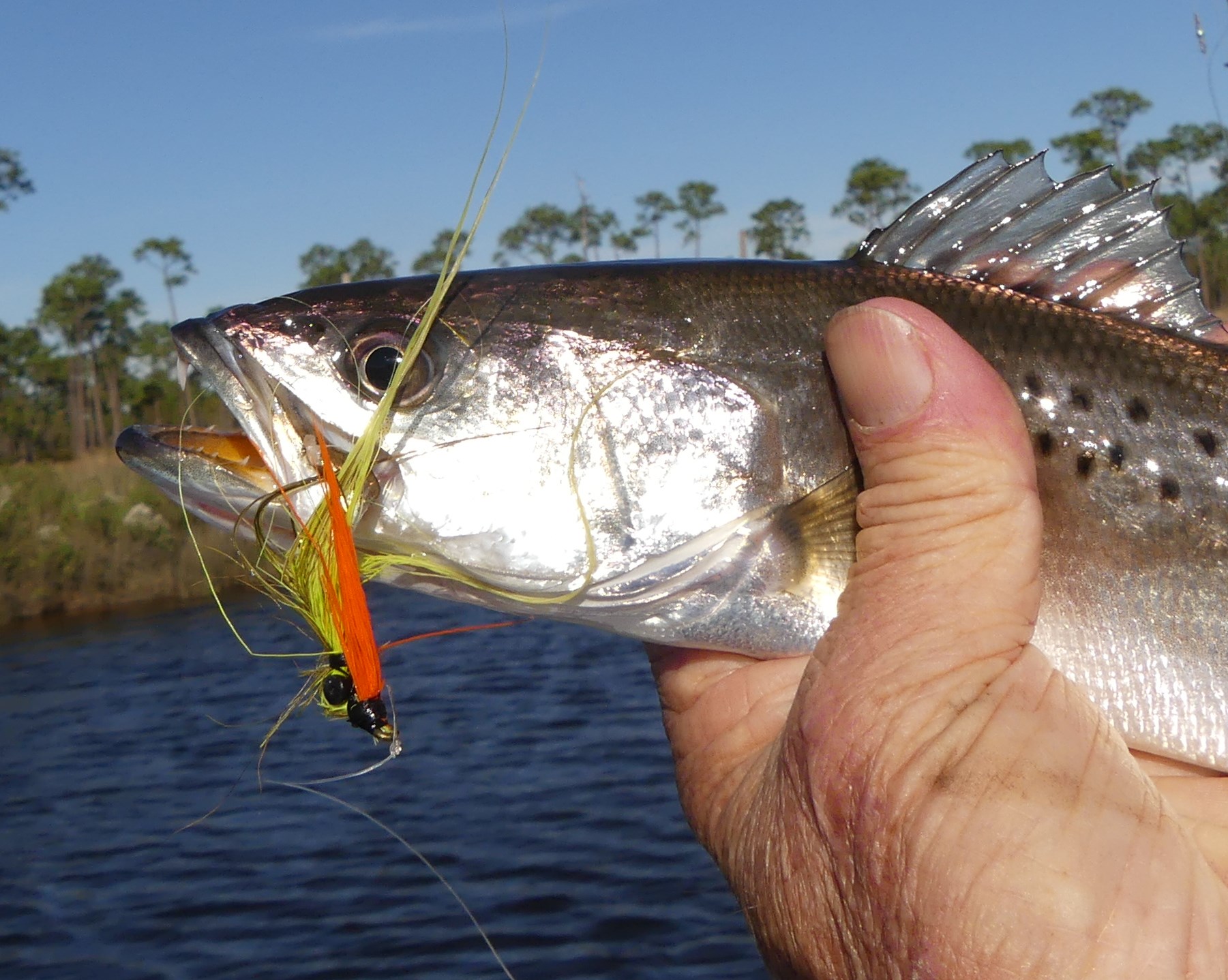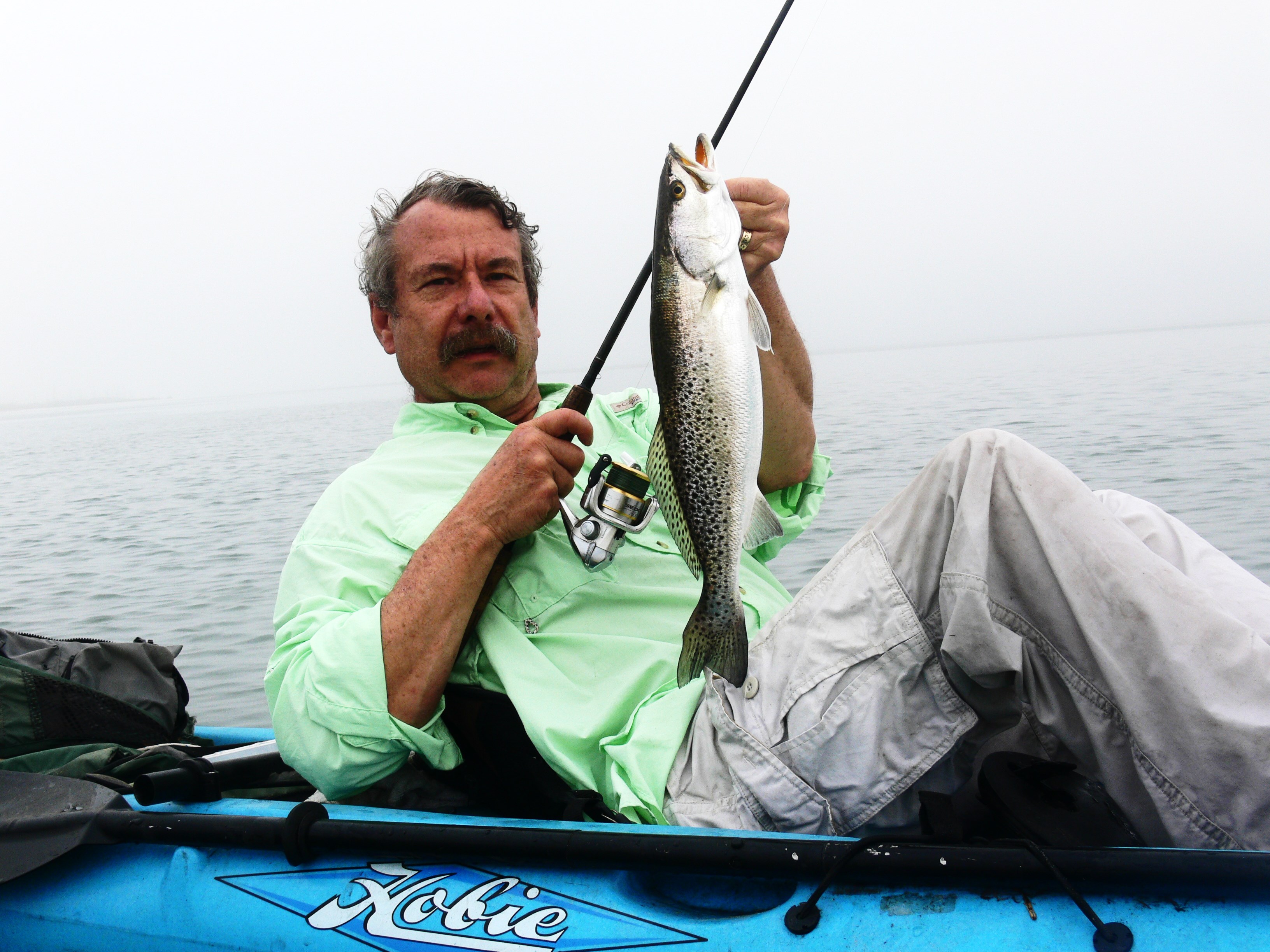Let the cold winds blow! Speckled trout are still here for our catching and eating pleasure.
No one will claim speckled trout fishing in February on the Gulf Coast is the same as during spring and summer, but the specks are still capable of being caught. We just have to go about things a little differently.
When the temperature of the wind and water fall, anglers must do their work in places and in ways that are not at all the same as earlier in the fishing year.
Where They Are- Cold Water Conditions
The first chore for a cold water speckled trout angler to accomplish is to find the fish. In cold weather and water times, specks are not scattered widely- they’re concentrated in big schools in very specific locations. And when we find them, we will usually find a lot of them.
Our buddy Captain Yano Serra of Coden, Alabama says,” The trout will be up in the rivers- in deeper holes. I find them in Dog River, near the Causeway, up the Mobile River in the deep holes. I look for ledges where the water depth moves from deep water to shallow. And this can vary. In the Theodore Industrial Canal, the deep water might be fifty feet deep. In Fowl River, a deep hole will be six feet deep. Deepwater varies from river to river, but that’s where the cold-water trout will be.”
In cold water times, specks like the deeper water because it tends to be a bit warmer, and the salinity is more to their liking. Also, this deep water is where the bait tends to congregate.

Fly rod anglers can catch specks on weighted, sinking flies. Photo by Floyd Chandler.
What They are Eating
In cold water conditions, the specks can’t afford to be picky. They must take advantage of any possible food source that comes their way.
Captain Yano tells us, “They will eat anything they can. They’re really slow in the cold water. They’ll eat baby crabs, little shrimp, little mullet, small croakers-whatever is there.”
This non-specific feeding pattern is good news for anglers. It’s much easier to tempt a cold-water speck that is eager for anything that is edible than a trout that is focused on one very specific size bait running in big, easy-to-find schools.
One of the best cold-water trout lures is the simplest- a ¼ oz. jighead with a soft plastic grub body. This lure can look like anything in the water, and it always looks like something a trout might want to eat.
How We Can Catch Them
Anglers fishing for cold water trout must get used to very subtle bites- the specks won’t take the rod from your hand when it’s cold.
Reels need to have the drag set very light, and when using live bait with multiple rods out, it is sometimes a good idea to attach a small bell to the rod tips to help anglers detect very light trout bites.
“Anglers should feel for the lure or bait to snag on a shell, but if the shell starts a headshake, it’s a good strike from a speck.”
The water in the Mobile Bay and other big water systems on the Gulf Coast is generally as clear as it ever gets during winter cold water conditions. This means that anglers who are using braided line- a good idea to help detect the light speck bites- will need to use a five to six-foot monofilament or fluorocarbon leader to keep the trout from being spooked by the solid braided line.
When fishing deeper water like in the Theodore Industrial Canal, Captain Yano likes to anchor on one of the many 16-foot-deep ledges and then cast to the deep water. A very slow retrieve with short hops of the lure or bait on the bottom works best. Anglers should feel for the lure or bait to snag on a shell, but if the shell starts a headshake, it’s a good strike from a speck.
A place that anglers find very good cold-water trolling and casting for speck is in Dog River between the marina and the west side of the bridge which crosses Dog River. This can be great trout fishing water. In particular, anglers can troll or cast lures- jigs with soft plastic bodies are best- and bounce the jig across the bottom. Feel for the lure as it “hops” off the bottom and then settles- most speck strikes will come as the jig settles back down.
Bait, Lures, and Rigs
A very simple yet very effective set up for cold water trout is probably already in most Gulf Coast anglers’ arsenals.
A medium to light spinning or level wind rod and reel with light line is standard. Anglers need to think light line and small bait presentations.
Captain Yano’s choice for a cold-water trout rig is simple. He says,” I like a three-inch long finger mullet rigged on a Carolina rig. Weight or jig heads no heavier than 3/8 oz. – smaller is better. I use a small “j” hook for this cold weather fishing because it doesn’t hang up on the bottom as much as bigger hooks or treble hooks.”
Another point that Captain Yano makes is that the leader being used should be lighter than the main line. This allows anglers to quickly and easily break off snagged lures and hooks with minimal re-rigging time. This cold water on the bottom fishing guarantees anglers that they will get snagged from time to time and lures and hooks will be lost.

Some very nice trout will come to February anglers who work deeper water slowly. Photo by Floyd Chandler.
Trolling- Very Effective in the Cold
A way to locate and catch the cold-water specks of winter is to troll for them. This is not a high-speed technique at all. It’s either using the wind, current, or a trolling motor to slowly drag lures and bait across the bottom of the rivers. This slow-troll allows anglers to cover a lot of water.
Captain Yano advises us, “I like trolling Fowl River. I like a grub on a jig head. DOA Shrimp is one of my favorite trolling lures.”
According to Yano, the key to successful trolling for cold water specks is to have no heavy line on the trolling rigs. Since the trout will be very near the bottom, bait and lures must get down deep to reach the fish. Heavy lines don’t sink as fast or stay deep as well as lighter lines.
Trolling a small-diameter braided line in 20 lb. weight is a good choice, and the mono leader needs to be lighter- say 12 or 15 lb. test.
When trolling, anglers need to be aware of any trash getting on the line. Anything which gets on the trolling line will kill the action and feel of any bites. Up in the rivers of the Gulf Coast, pine needles floating in the water are particularly common to snag on trolling lines, and they need to be removed immediately.
When asked how an angler needs to gear up for cold water trolling for specks, Captain Yano advises, “Put on lots of warm clothes. Make sure you have three Thermos jugs of coffee. And you need a good trolling motor with a hot battery.”
Sounds like a recipe for a lot of cold weather, cold water fishing fun to us.
Good Cold-Water Speck Trout Rivers
Alabama
- Dog River
- Fowl River
- Rabbit Creek
- Theodore Industrial Canal
- Tensaw River
- Magnolia River
- Bon Secour River
Florida
- Escambia River
- Blackwater River
- Perdido River
- East River
- Yellow River
Important Contact Information:
Captain Yano Serra
Speck-Tackle-Lure Inshore Fishing
251-610-0462
captainyano@hotmail.com
